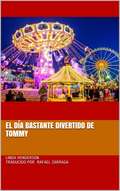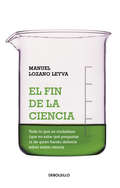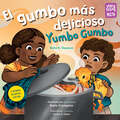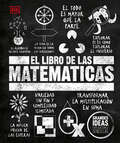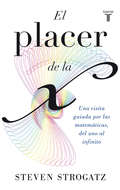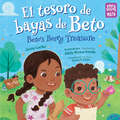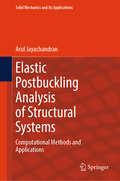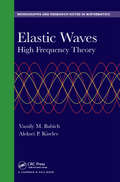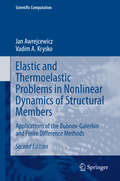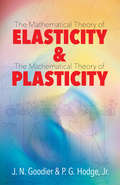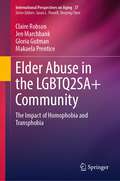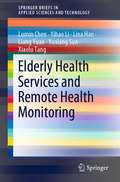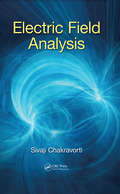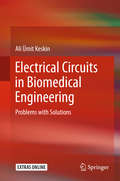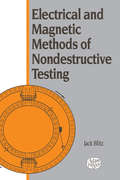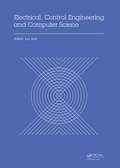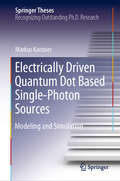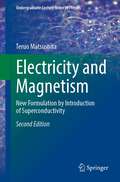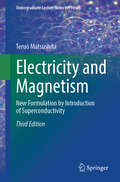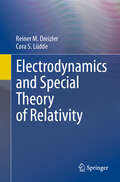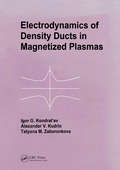- Table View
- List View
El día bastante divertido de Tommy
by Linda HendersonEl día bastante divertido de Tommy por Linda Henderson Además de practicar aritmética, Tommy aprende a tratar a la gente de manera justa en la feria. El día bastante divertido de Tommy Una feria promete tener experiencias interesantes para los jóvenes y también para los jóvenes de corazón. A Tommy le encanta las atracciones mecánicas y los animales de la feria. También le gusta sumar números en su cabeza. Fue entonces cuando descubrió que había muchas cosas que sumar en la feria. Estaba escuchando a su tío Al sumar el costo de las entradas, cuando su tío compartió una lección de vida sobre la importancia de tratar a la gente de manera justa e igualitaria. Todos podemos aprender de lo que el tío All le dijo a Tommy. En este libro, fácil de leer para niños de 6 a 8 años, los niños pueden divertirse con Tommy y su familia mientras recorren el recinto ferial. Pueden ejercitar sus mentes practicando las matemáticas. ¡Y al final del libro, los niños son introducidos al más justo de todos!
El fin de la ciencia: Todo Lo Que Un Ciudadano Debe Saber Sobre Ciencia Y No Sabe Cómo Preguntar Ni De
by Manuel Lozano LeyvaTodo lo que un ciudadano (que no sabe qué preguntar ni de quién fiarse) debería saber sobre ciencia. El fin de la ciencia responde a una doble pregunta: ¿se puede acabar la ciencia? y ¿qué busca la ciencia? Tras un irreverente recorrido por la historia de la ciencia y la tecnología, el prestigioso científico y gran divulgador Lozano Leyva realiza un ameno e inteligente recorrido por los riesgos y las amenazas actuales, desde la mediocridad y la falta de recursos hasta las pseudociencias o el negacionismo ambiental, para repasar a continuación sus objetivos en los campos más diversos. La idea de partida del libro es que los ciudadanos no pueden ejercer la democracia apropiadamente sin unos conocimientos básicos de lo que es la ciencia y la tecnología, incluidos no sólo sus grandezas y milagros, sino también sus miserias y peligros. La expansión del conocimiento científico y técnico que arrancó en el Renacimiento,tomó impulso en la Ilustración y eclosionó con las grandes y sangrientas convulsiones del siglo XX es un fenómeno único en la historia al que nos tenemos que enfrentar en el siglo XXI. Lo hemos de hacer ilusionados, sí, pero también alertas. Y nuestros políticos saben de esto lo mismo que los ciudadanos: poco o nada. Esclarecer esas ideas, o contribuir a hacerlo, es lo que pretende El fin de la ciencia. «Lo único que quiero con este libro es que cualquier persona tenga una razón más para meter un voto en la urna.»Manuel Lozano Leyva Reseña:«El fin de la ciencia se ocupa, principalmente, de revelar errores de juicio, supercherías notorias y campos donde la ciencia será decisiva en un futuro inmediato: la pesca, la alimentación, el suministro de agua, la prevención y el combate de enfermedades endémicas, etc.»Diario de Sevilla
El gumbo más delicioso / Yumbo Gumbo (Storytelling Math)
by Keila V. Dawson¡Celebra la diversidad, las matemáticas y el poder de contar cuentos en esta edición bilingüe (español e inglés)!Celebrate diversity, math, and the power of storytelling with this bilingual (Spanish and English) edition!¡Los abuelos de Annabelle finalmente le enseñarán a cocinar gumbo! Pero la familia no puede ponerse de acuerdo sobre qué tipo de gumbo hacer. Votan por su favorito, pero el resultado de la votación es un empate. ¿Y ahora qué? Una exploración lúdica de los datos y el razonamiento socioemocional, presentando personajes criollos de Luisiana y un glosario de palabras criollas de Luisiana.Storytelling Math celebra a los niños usando las matemáticas en sus aventuras diarias mientras juegan, construyen y descubren el mundo que les rodea. Historias alegres y actividades manuales hacen que sea fácil para los niños y sus adultos explorar las matemáticas cotidianas juntos. Desarrollado en colaboración con expertos en matemáticas de TERC, una organización educativa educativa sin fines de lucro con enfoque en en ciencia, tecnología, ingeniería y matemáticas (STEM, por sus siglas en inglés), bajo una subvención de la Fundación Heising-Simons.Annabelle's grandparents are finally going to teach her how to cook gumbo! But the family can't agree on what type of gumbo to make. They vote for their favorite, but the vote results in a tie. Now what? A playful exploration of data and social-emotional reasoning, featuring Louisiana Creole characters and a glossary of Louisiana Creole words.Storytelling Math celebrates children using math in their daily adventures as they play, build, and discover the world around them. Joyful stories and hands-on activities make it easy for kids and their grown-ups to explore everyday math together. Developed in collaboration with math experts at STEM education nonprofit TERC, under a grant from the Heising-Simons Foundation.
El libro de las matemáticas (DK Big Ideas)
by DKGrandes ideas, explicaciones sencillasEscrito en un lenguaje accesible, El libro de las matemáticas presenta explicaciones claras y concisas que desbrozan la jerga especializada, diagramas que plasman complejas teorías, citas memorables e ingeniosas ilustraciones que juegan con nuestras ideas acerca de los números.¿Qué es un número imaginario? ¿Cómo pueden servir las matemáticas para predecir el futuro? A lo largo de la historia, los matemáticos se han planteado grandes preguntas como estas, y han proporcionado respuestas que ayudan a comprenderlo todo, desde los patrones de la naturaleza hasta la tecnología informática actual.Tanto el alumno motivado como quien simplemente sienta curiosidad por las matemáticas se sentirán intrigados y estimulados por muchas de las ideas de este libro.
El placer de la X: Una visita guiada por las matemáticas, del uno al infinito (Humanidades/taurus Ser. #Vols. 318-319)
by Steven Strogatz¿Qué relación guardan los números con la literatura, el amor o la cultura pop? ¿Cuánto de exacto tiene la vida cotidiana? Un recorrido diferente por el asombroso mundo de las matemáticas. Un matemático de primer nivel y prestigioso divulgador del New York Times nos invita a una visita guiada por las grandes ideas de las matemáticas y sus sorprendentes conexiones con la literatura, la filosofía, la medicina o el arte. Las matemáticas están en la base de todo lo que hay en el cosmos, incluidos nosotros mismos, y, sin embargo, muy pocos entienden lo suficiente este idioma universal como para gozar de su sabiduría, su belleza... y sus placeres. Este libro lo traduce para convertirlo en algo inteligible y apasionante. Cada capítulo ofrece inesperados momentos de revelación: desde la explicación de por qué los números son tan útiles (y tan eficaces para describir el mundo) hasta los escondidos encantos del cálculo, laselipses y el teorema de Pitágoras. Steven Strogatz solo pide a sus lectores curiosidad y sentido común. A cambio, El placer de la X les ofrecerá explicaciones claras e ingeniosas de los principios esenciales de esta disciplina y de su extraordinario poder para responder a muchas de las preguntas de la vida cotidiana. El autor, premiado y elogiado por sus ensayos y artículos en múltiples medios de comunicación como The New York Times, New Yorker, Discover o Science, es reconocido internacionalmente por su manera didáctica de abarcar y exponer las matemáticas y otras disciplinas relacionadas. Reseñas:«Este delicioso libro le recordará lo bonitas y fascinantes que pueden ser las matemáticas. Steven Strogatz es el maestro que todos querríamos haber tenido.»Joshua Foer, autor de Moonwalking with Einstein «Una amena exploración de la belleza y la diversión que encierran las matemáticas. El placer de la X le entretendrá, le sorprenderá y le hará más inteligente.»Steven Pinker, profesor de Psicología en la Universidad de Harvard, autor de How the Mind Works y The Language Instinct «Es la lección de matemáticas perfecta: clara, instructiva y breve.»The Telegraph «Sus fácilmente asimilables capítulos incluyen multitud de ejemplos e ilustraciones. ¡Nunca volverá a olvidar el teorema de Pitágoras!»Scientific American «Este libro me enamoró desde la primera página. Con su particular ingenio y su simpático encanto, Strogatz desmonta las matemáticas como una disciplina temida y venerada, y las vuelve a ensamblar para formar un nuevo mundo, a la vez accesible y mágico. El placer de la X es, pues, un placer.»Janna Levin, profesora de Física y Astronomía en la Universidad de Columbia, y autora de How the Universe Got Its Spots y A Madman Dreams of Turing Machines «Este libro es, en una palabra, fantástico. Introduceal lector en los conceptos que subyacen en las matemáticas. En un mundo donde las matemáticas son imprescindibles y, sin embargo, mal comprendidas, las destrezas didácticas de Steve Strogatz y su hábil estilo literario son una contribución primordial.»Lisa Randall, profesora de Ciencia de la Universidad de Harvard, y autora de Warped Passages y Knocking on Heaven´s Door «Strogatz ha descubierto una función mágica que transforma "matemáticas" en "placer", página tras página. Toma todo lo que siempre le desconcertó de las matemáticas y lo hace más que inteligible: lo hace asombroso, atractivo y fascinante.»Daniel Gilbert, profesor de Psicología en la Universidad de Harvard, y autor de Stumbling on Happiness
El planeta vacío: El shock del declive de la población mundial
by John Ibbitson Darrell BrickerBienvenidos a la caída de la población mundial. Durante medio siglo, muchos estadistas, políticos, analistas y estudiosos han alertado sobre una explosión demográfica que pondrá en jaque los recursos del planeta. Sin embargo, un creciente número de expertos tiene en el punto de mira otro motivo de alarma: en lugar de aumentar exponencialmente, la población mundial se encamina hacia un fuerte descenso que ya es evidente en muchos lugares. En El planeta vacío, los autores revelan cómo esta caída de la población traerá consigo distintos beneficios: el riesgo de hambrunas disminuirá, la situación medioambiental mejorará, menos trabajadores exigirán mejores salarios y unas tasas de natalidad más bajas representarán mayores ingresos y autonomía para las mujeres. Pero no todo son buenas noticias. Ya podemos ver los efectos del envejecimiento de la población en Europa y algunos puntos de Asia, y cómo la escasez de trabajadores debilita la economía e impone unas exigencias desmesuradas en el campo de la salud pública. Reseñas...«Si bien el género "todo lo que sabes es falso" se ha vuelto agotador, este libro contiene información fascinante y de vital importancia. Los datos reveladores de Bricker e Ibbitson demuestran, con una prosa enérgica e incisiva, que en el mundo se está operando un cambio radical sin que nadie se dé cuenta.»Steven Pinker «Aun cuando la población mundial esté aumentando, la tasa de natalidad ya ha empezado a caer en todo el mundo. En otros tiempos, los descensos de población se debieron a desastres naturales como la erupción del Toba, la peste negra o la gripe, pero la caída que viene ahora será cosa exclusivamente nuestra. En este sugerente libro, Bricker e Ibbitson debaten acerca de por qué, hacia finales del siglo XXI, no habrá una superpoblación global sino una rápida disminución demográfica, al tiempo que proponen medios para adaptarnos a ella.»Lewis Dartnell, profesor de comunicación científica en la Universidad de Westminster y autor de Abrir en caso de apocalipsis «Para comprender el futuro debemos cuestionar nuestras suposiciones, y la mayor de todas es que la población sigue creciendo, algo que muchos creemos. Bricker e Ibbitson nos ofrecen un desafío revelador, que debería ser tomado muy en serio por todo aquel que se preocupe por el futuro a largo plazo (que, espero, seamos todos).»Dan Gardner, autor de Risk y coautor de Superforecasting: The Art and Science of Prediction «Un libro muy ameno, una visión controvertida sobre una realidad sobre la que se reflexiona poco: un mundo despoblado y una urbanización creciente.»George Magnus, autor de The Age of Aging y Red Flags: Why Xi's China Is in Jeopardy
El tesoro de bayas de Beto / Beto's Berry Treasure (Storytelling Math)
by Jenny Lacika¡Celebra la diversidad, las matemáticas y el poder de la narración con esta edición bilingüe (español e inglés)! Un libro ilustrado de matemáticas para preescolares y niños de kínder con el cual es fácil relacionarse, ya que es parte de la experiencia cotidiana de los niños más pequeños.Celebrate diversity, math, and the power of storytelling with this bilingual (Spanish and English) edition!A math picture book for preschoolers and kindergarteners that&’s relatable and part of little kids&’ everyday experience.Beto quiere jugar a la fiesta de té con Cora, pero su hermana mayor solo quiere ser pirata. Para convencer a Cora, Beto crea un mapa hacia un delicioso tesoro escondido. ¡Pero Cora termina en el lugar equivocado! ¿Encontrará Cora el tesoro antes de que Beto se lo coma todo?Storytelling Math celebra a los niños que usan las matemáticas en sus aventuras diarias mientras juegan, construyen y descubren el mundo que los rodea. El tesoro de bayas de Beto es una exploración divertida del mapeo, con personajes chicanxs (mexicoamericanes).Beto wants to play tea party with Cora, but his big sister just wants to be a pirate. To get Cora on board, Beto makes a map to a delicious hidden treasure. But Cora ends up in the wrong place! Will Cora find the treasure before Beto eats it all?Storytelling Math celebrates children using math in their daily adventures as they play, build, and discover the world around them. Beto&’s Berry Treasure is a playful exploration of mapping, featuring Chicanx (Mexican American) characters.
Elastic Postbuckling Analysis of Structural Systems: Computational Methods and Applications (Solid Mechanics and Its Applications #232)
by Arul JayachandranThis book presents a unified computational approach to postbuckling stability analysis of structures using the Total Potential Energy (TPE) framework. It builds upon the secant matrix technique (N1-N2 method) and introduces the Variable Order Secant Matrix (VoSM) method, providing a robust framework for analyzing reticulated, framed, continuum, and thin-walled systems under large deformations. The book derives the geometric nonlinear finite element formulations using Total Lagrangian (TL) and co-rotational TL formats, ensuring accurate postbuckling analysis. It includes benchmark problems and numerical case studies, making it a valuable resource for graduate students, researchers, and faculty involved in structural stability and advanced postbuckling investigations. Additionally, it serves as an indispensable reference for analyzing and designing steel structures.
Elastic Waves: High Frequency Theory (Chapman & Hall/CRC Monographs and Research Notes in Mathematics)
by Vassily Babich Aleksei KiselevElastic Waves: High Frequency Theory is concerned with mathematical aspects of the theory of high-frequency elastic waves, which is based on the ray method. The foundations of elastodynamics are presented along with the basic theory of plane and spherical waves. The ray method is then described in considerable detail for bulk waves in isotropic and anisotropic media, and also for the Rayleigh waves on the surface of inhomogeneous anisotropic elastic solids. Much attention is paid to analysis of higher-order terms and to generation of waves in inhomogeneous media. The aim of the book is to present a clear, systematic description of the ray method, and at the same time to emphasize its mathematical beauty. Luckily, this beauty is usually not accompanied by complexity and mathematical ornateness.
Elastic and Thermoelastic Problems in Nonlinear Dynamics of Structural Members: Applications of the Bubnov-Galerkin and Finite Difference Methods (Scientific Computation)
by Jan Awrejcewicz Vadim A. KryskoFrom the reviews: "A unique feature of this book is the nice blend of engineering vividness and mathematical rigour. [...] The authors are to be congratulated for their valuable contribution to the literature in the area of theoretical thermoelasticity and vibration of plates." Journal of Sound and Vibration
Elasticity and Plasticity: The Mathematical Theory of Elasticity and The Mathematical Theory of Plasticity (Dover Books on Mathematics)
by J. N. Goodier P. G. Hodge Jr.This volume comprises two classic essays on the mathematical theories of elasticity and plasticity by authorities in this area of engineering science. Undergraduate and graduate students in engineering as well as professional engineers will find these works excellent texts and references. The Mathematical Theory of Elasticity covers plane stress and plane strain in the isotropic medium, holes and fillets of assignable shapes, approximate conformal mapping, reinforcement of holes, mixed boundary value problems, the third fundamental problem in two dimensions, eigensolutions for plane and axisymmetric states, anisotropic elasticity, thermal stress, elastic waves induced by thermal shock, three-dimensional contact problems, wave propagation, traveling loads and sources of disturbance, diffraction, and pulse propagation. The Mathematical Theory of Plasticity explores the theory of perfectly plastic solids, the theory of strain-hardening plastic solids, piecewise linear plasticity, minimum principles of plasticity, bending of a circular plate, and other problems.
Elder Abuse in the LGBTQ2SA+ Community: The Impact of Homophobia and Transphobia (International Perspectives on Aging #37)
by Gloria Gutman Claire Robson Jen Marchbank Makaela PrenticeThis book describes and analyzes the lived experience of elder abuse from the queer community. It discusses the experiences by transwomen, gay men and lesbians of financial abuse, physical and sexual abuse, homophobic abuse, and neglect within partner relationships, residential care, in home care, and religious organizations. Queer and trans elders have been described as ‘The Silent Generation’, since they have lived through times when their sexual and gender identities were criminalized and pathologized. The book shows that they are far more at risk to suffer abuse and neglect by those they should be able to trust, since they are more likely to have encountered all key risk factors, such as isolation, previous abuse and trauma, and mistrust of the health care system. Their vulnerability has been overlooked and this book addresses that gap. As such, this book provides a great resource to anyone working with elders, including medical professionals, care providers, police, counsellors, and policy makers.
Eldercare Labor Demand in China and Coping Strategies
by Yali ZhuThis book employs Markov models and propensity score matching methods to analyze the demand for elderly care labor, utilizing data from the China Longitudinal Healthy Longevity Survey (CLHLS) and World Population Prospects 2022 (United Nations, 2022). The model predicts the health transferring scenario among the aging population firstly, and then the demand for elderly care labor from 2022 to 2058 under a fixed care time demand scenario according to 8-hour working system, as well as national and provincial regulations on caregiver-carereceiver ratios. The accelerated aging process and rapid increase in the younger elderly population will result in a rapid increase in the demand for elderly care labor for the healthy elderly until about 2042, with a 1.5-fold increase. This is followed by accelerated growth in the demand for elderly care labor for the impaired and dysfunctional aging population. Over time, the supply of older adults without care will gradually increase, nearly doubling by 2058 compared to 2022. It is recommended that on the one hand, eldercare labor demand in China can be reduced from the origin by improving the health of the population; and on the other hand, the effective supply of elderly care be expanded by building a modern care service system, improving relevant policies, integrating care resources, and innovating the supply model.
Eldercare Work in Contemporary China: The Nexus of State, Family, and Market
by Zhe YanThis book gives voice to an indispensable yet often overlooked group of care workers in China&’s eldercare industry. Drawing on rich, first-hand accounts from frontline care workers and interwoven with a wealth of sociological insights, the author offers a critical yet nuanced analysis of how statutory norms, cultural values, institutional standards, and interpersonal dynamics shape the experiences, motivations, and coping strategies of professional care workers. The book compellingly illustrates the stark contrast between the high expectations and demands placed upon these workers and the low pay and status they receive in return. A key strength of the book lies in its holistic approach, which not only contextualizes the challenges faced by care workers but also explores their search for meaning within an increasingly marketized and rapidly evolving cultural landscape. By shedding light on the intersection of care work, policy, economy and socio-cultural values, the book offers a fresh analytical lens on the precariousness and resilience of care workers. It provides critical insights into how these workers navigate structural constraints, drawing on personal agency and cultural resources to find purpose and dignity in their roles. In doing so, the book makes a significant contribution to debates on labor, aging, and care in contemporary China, offering valuable implications for policymakers, researchers, and practitioners alike.
Elderly Health Services and Remote Health Monitoring (SpringerBriefs in Applied Sciences and Technology)
by Lina Han Yihao Li Lumin Chen Liang Yuan Yuxiang Sun Xiaolu TangThis book focuses on typical health services and remote monitoring methods, such as visual recognition and deep learning. Chiefly addressing the design and simulation of rehabilitation devices, and the evaluation of their effects on various diseases, it offers a valuable resource for professional researchers and graduate students in the fields of elderly medicine, signal processing, and rehabilitation.
Electric Field Analysis
by Sivaji ChakravortiElectric Field Analysis is both a student-friendly textbook and a valuable tool for engineers and physicists engaged in the design work of high-voltage insulation systems. The text begins by introducing the physical and mathematical fundamentals of electric fields, presenting problems from power and dielectric engineering to show how the theories are put into practice. The book then describes various techniques for electric field analysis and their significance in the validation of numerically computed results, as well as: <P><P>Discusses finite difference, finite element, charge simulation, and surface charge simulation methods for the numerical computation of electric fields Provides case studies for electric field distribution in a cable termination, around a post insulator, in a condenser bushing, and around a gas-insulated substation (GIS) spacer Explores numerical field calculation for electric field optimization, demonstrating contour correction and examining the application of artificial neural networks Explains how high-voltage field optimization studies are carried out to meet the desired engineering needs Electric Field Analysis is accompanied by an easy-to-use yet comprehensive software for electric field computation. The software, along with a wealth of supporting content, is available for download with qualifying course adoption.
Electrical Circuits in Biomedical Engineering
by Ali Ümit KeskinThis book presents a comprehensive and in-depth analysis of electrical circuit theory in biomedical engineering, ideally suited as textbook for a graduate course. It contains methods and theory, but the topical focus is placed on practical applications of circuit theory, including problems, solutions and case studies. The target audience comprises graduate students and researchers and experts in electrical engineering who intend to embark on biomedical applications.
Electrical and Magnetic Methods of Nondestructive Testing
by Jack BlitzElectrical and Magnetic Methods of Nondestructive Testing presents a comprehensive account of the electrical and magnetic methods of nondestructive testing (NDT). The book begins with a discussion of the requirements for NDT and the criteria for the choice of a given method, followed by a summary of the general theory relating to electrical and magnetic testing techniques. Subsequent chapters discuss specific methods, including eddy current and flux-leakage techniques and microwave and potential drop methods. The appendix provides some useful programs for eddy current impedance analyses. These programs are in BASIC and can be run on PCs.
Electrical, Control Engineering and Computer Science: Proceedings of the 2015 International Conference on Electrical, Control Engineering and Computer Science (ECECS 2015, Hong Kong, 30-31 May 2015)
by Jian LiuElectrical, Control Engineering and Computer Science includes the papers from ECECS2015 (Hong Kong, 30-31 May 2015), which was organized by the American Society of Science and Engineering (ASEE), a non-profit society for engineers and scientists. Presenting new theories, ideas, techniques and experiences related to all aspects of electrical enginee
Electrically Driven Quantum Dot Based Single-Photon Sources: Modeling and Simulation (Springer Theses)
by Markus KantnerSemiconductor quantum optics is on the verge of moving from the lab to real world applications. When stepping from basic research to new technologies, device engineers will need new simulation tools for the design and optimization of quantum light sources, which combine classical device physics with cavity quantum electrodynamics. This thesis aims to provide a holistic description of single-photon emitting diodes by bridging the gap between microscopic and macroscopic modeling approaches. The central result is a novel hybrid quantum-classical model system that self-consistently couples semi-classical carrier transport theory with open quantum many-body systems. This allows for a comprehensive description of quantum light emitting diodes on multiple scales: It enables the calculation of the quantum optical figures of merit together with the simulation of the spatially resolved current flow in complex, multi-dimensional semiconductor device geometries out of one box. The hybrid system is shown to be consistent with fundamental laws of (non-)equilibrium thermodynamics and is demonstrated by numerical simulations of realistic devices.
Electricity and Magnetism: New Formulation by Introduction of Superconductivity (Undergraduate Lecture Notes in Physics)
by Teruo MatsushitaThis book is a very comprehensive textbook covering in great depth all the electricity and magnetism. The 2nd edition includes new and revised figures and exercises in many of the chapters, and the number of problems and exercises for the student is increased.In the 1st edition, emphasis much was made of superconductivity, and this methodology will be continued in the new edition by strengthening of the E-B analogy. Many of the new exercises and problems are associated with the E-B analogy, which enables those teaching from the book to select suitable teaching methods depending on the student’s ability and courses taken, whether physics, astrophysics, or engineering.Changes in the chapters include a detailed discussion of the equivector-potential surface and its correspondence between electricity and magnetism. The shortcomings of using the magnetic scalar potential are also explained. The zero resistivity in a magnetic material showing perfect diamagnetism can be easily proved.This textbook is an ideal text for students, who are competent in calculus and are taking physics, astrophysics, or engineering at degree level. It is also useful as a reference book for the professional scientist.
Electricity and Magnetism: New Formulation by Introduction of Superconductivity (Undergraduate Lecture Notes in Physics)
by Teruo MatsushitaThis comprehensive textbook covers electricity and magnetism in great depth, with the 3rd edition offering updated descriptions of electromagnetic phenomena to help students achieve a more thorough understanding of the subject. In the 1st edition, superconductivity was emphasized, a focus that continued in the 2nd edition, which strengthened the E-B analogy by comparing equipotential surfaces in electricity to equivector potential surfaces in magnetism. The 3rd edition introduces the concept of mean magnetic flux, which aids in determining inductance from magnetic energy. It also demonstrates how vector potential can be directly used to calculate electromotive force. A unique phenomenon is presented when applying current to a superconducting transmission line, where the induced electric field's vector potential is perpendicular to the current. This deviation from common equations can still be explained through Maxwell&’s theory, leading to the correct solution. For a more in-depth grasp of electricity and magnetism, students are encouraged to use Exercises in Electricity and Magnetism by the same author, which offers 400 practice problems. This textbook is ideal for advanced students of physics, astrophysics, or engineering, as well as a valuable reference for professional scientists.
Electrodynamics and Special Theory of Relativity
by Reiner M. Dreizler Cora S. LüddeThis textbook offers you a profound understanding of the core concepts in electrodynamics and the special theory of relativity. Emphasis is placed on establishing strong mathematical fundamentals while also equipping you with problem-solving skills crucial for mastering these disciplines. It covers electromagnetic theory, encompassing Maxwell's equations and electromagnetic wave theory as well as special theory of relativity, including space-time principles and the Lorentz transformation.
Electrodynamics of Density Ducts in Magnetized Plasmas: The Mathematical Theory of Excitation and Propagation of Electromagnetic Waves in Plasma Waveguides
by I G Kondratiev A V Kudrin T M ZaboronkovaProviding a systematic and self-contained treatment of excitation, propagation and re- emission of electromagnetic waves guided by density ducts in magnetized plasmas, this book describes in detail the theoretical basis of the electrodynamics of ducts. The classical dielectric-waveguide theory in open guiding systems in magnetoplasma is subjected to rigorous generalization. The authors emphasize the conceptual physical and mathematical aspects of the theory, while demonstrating its applications to problems encountered in actual practice. The opening chapters of the book discuss the underlying physical phenomena, outline some of the results obtained in natural and artificial density ducts, and describe the basic theory crucial to understanding the remainder of the book. The more specialized and complex topics dealt with in subsequent chapters include the theory of guided wave propagation along axially uniform ducts, finding the field excited by the source in the presence of a duct, excitation of guided modes, the asymptotic theory of wave propagation along axially nonuniform ducts, and mode re-emission from a duct. The full wave theory is used throughout most of the book to ensure consistency, and the authors start with simpler cases and gradually increase the complexity of the treatment.
Electromagnetic Fields Excited in Volumes with Spherical Boundaries (Lecture Notes In Electrical Engineering #523)
by Victor A. Katrich Yuriy M. Penkin Sergey L. Berdnik Mikhail V. Nesterenko Victor M. DakhovThis book discusses the problem of electromagnetic wave excitation in spatial regions with spherical boundaries and the accurate mathematical modeling based on numerical and analytical methods to significantly reduce the time required for developing new antenna devices. It particularly focuses on elements and systems on mobile objects of complex shape that are made of new technological materials. The experimental development of such devices and systems is an extremely time-consuming, lengthy, and expensive process. The book is intended for senior and postgraduate students and researchers working in the fields of radiophysics, radio engineering and antenna design. The authors assume that readers understand the basics of vector and tensor analysis, as well as the general theory of electrodynamics. The original results presented can be directly used in the development of spherical antennas and antenna systems for the mobile objects. The book addresses problems concerning the construction of Green’s functions for Hertz potentials in electrodynamic volumes with spherical boundaries, and solves these clearly and concisely. It also uses specific examples to analyze areas where the results could potentially be applied. The book covers the following topics: · excitation of electromagnetic fields in coordinate electrodynamic volumes; · Green’s functions for spherical resonators; · Green’s functions for infinite space outside of spherical scatterers; · electromagnetic fields of dipole radiators on spherical scatterers; · electromagnetic fields of thin radial impedance vibrators on perfectly conducting spheres; · electrodynamic characteristics of narrow slots in spherical surfaces; · multi-element and combined vibrator-slot radiators on spherical surfaces.
